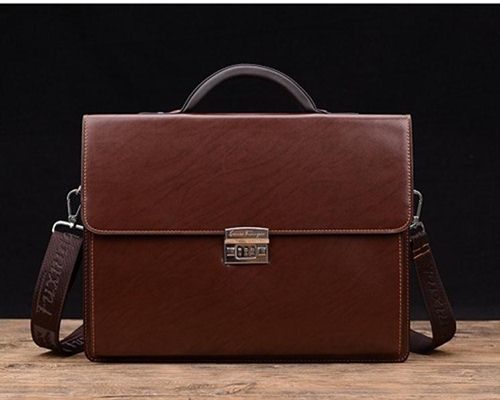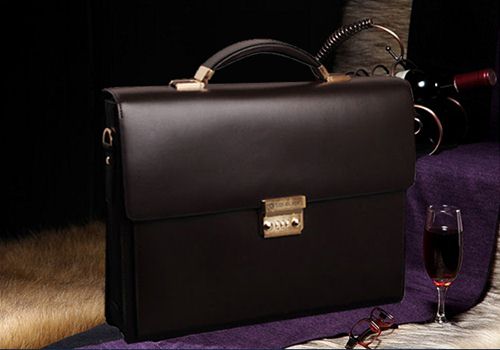Tiêu đề nội dung
Nếu là một người yêu thích thời trang chắc chắc bạn sẽ hiểu rằng trang phục cùng phụ kiện luôn có vai trò thể hiện được tính cách cùng phong cách của bạn. Với phái mạnh trong công việc cũng như cuộc sống hằng ngày những chiếc cặp da là vật dụng không thể thiếu. Chọn một chiếc cặp da công sở nam sao cho phù hợp với phong cách của mình là điều mà nhiều chàng quan tâm. Hãy cùng Ngọc Quang tìm hiểu cách chọn cặp da theo tính cách nhé!

Cách lựa chọn cặp da công sở nam theo tính cách từng người
Với những quý ông điềm tĩnh phong cách thời trang của họ sẽ có phần giản dị, không màu mè nhưng toát lên sự thanh lịch.
1. Lựa chọn cặp da cho người có tính cách điềm tĩnh
Chỉ cần khoác lên mình bộ bộ vest đơn giản anh chàng đã trở nên rất men lì trong mắt người đối diện rồi. Kết hợp cùng bộ trang phục này chàng có thể chọn cho mình một chiếc cặp da công sở với gam màu nâu hoặc đen. Những chiếc cặp da công sở thường có thiết kế dạng xách tay đơn giản với ngăn lớn để đựng máy tính hoặc tài liệu, cùng đồ dùng cá nhân.
Thiết kế của những chiếc cặp này tuy không quá cầu kỳ nhưng chắc chắn sẽ mang đến cho chàng một vẻ ngoài điềm tĩnh, trưởng thành.
2. Lựa chọn cặp da công sở cho người thích sự quyền lực
Những quý ông có tính cách mạnh mẽ, thích thể hiện sự quyền lực của riêng mình thì việc lựa chọn cho mình một chiếc cặp da cao cấp cần có sự tỉ mỉ hơn.
Những anh chàng thích thể hiện vị trí của bản thân thì một chiếc cặp da mà chàng mang theo chắc chắn sẽ toát lên vẻ khác biệt khó nhầm lẫn. Những chiếc cặp khóa số kim loại là lựa chọn hoàn hảo cho chàng.

3. Cặp da công sở nam cho phong cách bụi bặm, lãng tử
Những anh chàng yêu thích phong cách phóng khoáng, trẻ trung thường yêu thích sự phá cách trong trang phục. Chàng có thể xuất hiện với một vẻ ngoài nghịch ngợm cùng chiếc cặp da đeo chéo.
Cặp đeo chéo luôn là món phụ kiện được nhiều anh chàng ưu chuộng vì sự tiện lợi của chúng. Với anh chàng không thích cầm bất cứ thứ gì trên tay khi đi ra ngoài thì túi đeo chéo là một lựa chọn không thể phù hợp hơn.
Mỗi con người đều có cho riêng mình những tính cách riêng. Tính cách quyết định khá lớn đến phong cách thời trang của họ. Mỗi phong cách sẽ mang đến cho bạn những điểm cuốn hút của riêng mình. Hãy tự tin để thể hiện bản thân mình trước tất cả mọi người. Ngọc Quang thiên đường túi da rất vui khi được đồng hành để mang đến phong cách cho riêng bạn.
4. Cặp da công sở lựa chọn của tất cả mọi người
Không chỉ phái nữ mà cánh mày râu giờ đây cũng hết sức quan tâm đến vẻ bề ngoài của mình. Việc có kiến thức tốt về thời trang và phụ kiện luôn là ưu điểm để chàng dễ dàng xây dựng cho mình phong cách hoàn hảo. Nếu nói về thời trang nam thì không thể bỏ qua phụ kiện túi da cao cấp.
Xu hướng cặp da công sở nam
Cặp da công sở nam đã trở thành vật dụng không thể thiếu của các chàng. Không chỉ dừng lại ở tác dụng đựng đồ đạc, một chiếc cặp da còn ảnh hưởng đến cả tổng thể bộ trang phục mà cánh mày râu khoác trên mình.
Nếu là tín đồ của thời trang cặp da sẽ có thể nhận thấy được xu hướng của đồ dùng này có những sự khác biệt ở những chi tiết như thân cặp, khóa cặp, màu sắc hay chất liệu.
Không chỉ các cô nàng mà cả cánh mày râu cũng là những tín đồ yêu thích thời trang và muốn tìm hiểu về chúng. Nắm được xu hướng thời trang chính là cách để bạn có thể diện những sét đồ thật sành điệu tại bất cứ đâu. Xu hướng của mỗi năm đều có sự chuyển biến tích cực.
Việc nắm được xu hướng cặp da công sở giúp các chàng trở nên nổi bật ở bất cứ đâu. Đặc biệt là những anh chàng công sở thì vẻ bề ngoài giúp gây được thiện cảm cũng như mở ra được nhiều cơ hội trong làm việc và gặp gỡ đối tác.

1. Bất ngờ với hình dáng của chiếc cặp da công sở
Cặp da nam mặc dù rất đa dạng về mẫu mã cùng kiểu dáng. Nhưng năm 2018 chắc chắn bạn sẽ phải bất ngờ với những chiếc cặp da công sở có hình vuông, hình chữ nhật cho tới những chiếc cặp có hình thang độc đáo, tinh tế.
Kích thước của những chiếc cặp da nam cũng sẽ được điều chỉnh để phù hợp với mục đích sử dụng như đựng tài liệu, giấy tờ, máy tính bảng, máy tính xách tay…
2. Xu hướng bản cài kim loại, cặp khóa số lên ngôi
Khóa cặp là chi chiết vô cùng quan trọng vì trong chiếc cặp của nam giới là những vật dụng vô cùng quan trọng.
Khóa cặp còn là chi tiếp tôn vinh được nét sang trọng và đẳng cấp của chiếc cặp da công sở nam. Không một chiếc cặp da cao cấp nào có thể xem nhẹ chi tiết khóa cặp. Xu hướng của năm 2018 ưa chuộng mẫu cặp có bản cài kim loại hoặc mẫu cặp khóa số cao cấp.
3. Xu hướng màu sắc cổ điển và hiện đại
Cặp da công sở nam cũng rất đa dạng về màu sắc. Những màu sắc thuộc 2 phong cách cổ điển và hiện đại vẫn luôn chiếm ưu thế.
Những màu sắc như nâu, nâu đỏ, nâu cà phê, đen thể hiện sự sang trọng, lịch lãm. Còn những chiếc cặp màu sắc hiện đại như xanh navy, nâu vàng, nâu đen mang đến nét phóng khoáng, cá tính.
Lý do khiến người nhỏ con phải kỹ khi chọn cặp da công sở nam?
Tại sao lại có thể khẳng định những anh chàng nhỏ con cần phải cẩn thận hơn hẳn người khác khi chọn mua cặp cho mình? Đó là bởi vì nếu không chọn lựa được một chiếc cặp nam phù hợp, bạn chẳng những không thể che giấu được khuyết điểm của mình mà còn khiến nó hiện ra một cách rõ nét hơn trong mắt mọi người xung quanh. Nhất là khi khuyết điểm chiều cao rất dễ khiến người khác nhận ra nếu bạn không biết cách phối kết hợp thời trang hài hòa.
Trên thực tế, với một chiếc cặp xách nam cao cấp, từ kiểu dáng, kích thước, màu sắc cho tới chất liệu luôn đóng vai trò rất quan trọng trong việc xây dựng hình ảnh và định hình phong cách của người sử dụng. Chỉ cần sở hữu một chiếc cặp có đầy đủ các yếu tố tương xứng với vóc dáng, bạn sẽ có thể tự tin trở nên nổi bật, cuốn hút và tự tin hơn trong bất kỳ hoàn cảnh nào. Chính vì vậy, hãy thật cẩn trọng khi chọn mua cặp túi xách nam nhé!

1. Không nên sở hữu môt chiếc cặp da công sở nam đeo chéo
Hiện nay, cặp nam đeo chéo là một trong số những mẫu cặp được rất nhiều nam giới yêu chuộng bởi sự trẻ trung, hiện đại cùng thiết kế nhỏ gọn và tiện dụng của nó. Đặc biệt, mẫu cặp này dường như đã gắn liền với cuộc sống của các bạn học sinh, sinh viên hay những cánh mày râu yêu thích phong cách năng động, bụi bặm. Tuy nhiên, nếu bạn là một anh chàng sở hữu chiều cao khiêm tốn thì không nên ‘làm liều’ với mẫu cặp đeo chéo này, bởi kiểu đeo đặc trưng mang tính ‘luộm thuộm’ của nó sẽ chỉ khiến cho khuyết điểm chiều cao của bạn bộc lộ một cách rõ nét hơn mà thôi.
Nhưng nếu bạn thực sự rất yêu thích mẫu cặp này thì vẫn có thể sử dụng bằng cách tìm kiếm một kiểu cặp chéo có kích thước nhỏ, dây đeo ngắn và bản nhỏ với màu sắc thực sự phù hợp. Có một điều cực kỳ phải lưu ý là bạn tuyệt đối không được đeo cặp dài ngang hông hay dưới hông nhé, hãy đeo nó trên hông để trông bạn được cao hơn.
2. Nên chọn mẫu cặp da cầm tay có chất liệu mềm
Thay vì là cặp chéo nam, mẫu cặp cầm tay có chất liệu mềm sẽ là sự lựa chọn phù hợp hơn dành cho những anh chàng thấp bé nhẹ cân. Khi chọn mua mẫu cặp nam này, bạn cũng cần lưu ý một số điểm như sau:
- Chọn mẫu cặp có kích thước vừa phải.
- Nên mua các mẫu cặp nam hàng hiệu bởi chúng thường có thiết kế đẹp mắt, tinh tế và cực kỳ sang trọng. Điều đó sẽ giúp che lấp phần nào nhược điểm về vóc dáng của bạn.
- Chọn mua cặp xách nam cầm tay có màu sắc trầm tối nhưu màu đen, xanh tím than, xám… để có thể kết hợp trang phục và các phụ kiện khác một cách dễ dàng hơn.
3. Mẫu cặp da công sở Clutch là sự lựa chọn hoàn hảo
Có thể nói với những anh chàng nhỏ con thì kiểu cặp Clutch chính là sự lựa chọn hoàn hảo nhất. Clutch với thiết kế tinh tế, sang trọng, tính năng tiện dụng sẽ mang đến cho bạn sự tự tin trong bất cứ hoàn cảnh nào, dù là đi làm, đi chơi, dạo phố hay tham dự sự kiện, tiệc tùng… Ngoài ra, khi kết hợp mẫu cặp nam cao cấp này với một bộ suit lịch lãm thì trông bạn sẽ càng trở nên cá tính, phong cách, chuyên nghiệp và cuốn hút hơn đấy nhé.
Hy vọng rằng những gợi ý trên đây đã có thể giúp những anh chàng có chiều cao khiêm tốn tự tin hơn khi chọn mua cặp nam đẹp cho mình. Nếu bạn còn đang băn khoăn thì hãy đến ngay Ngọc Quang để được tư vấn, hỗ trợ và chiêm ngưỡng những mẫu cặp xách nam mới nhất nhé!
Từ khóa:
- Cặp da công sở nam TPHCM
- Cặp da bò công sở
- Túi xách nam đi công tác
- Cặp da bò nam TPHCM
- Cặp đi làm công sở
- Cặp da nam cao cấp
Nội dung liên quan:
